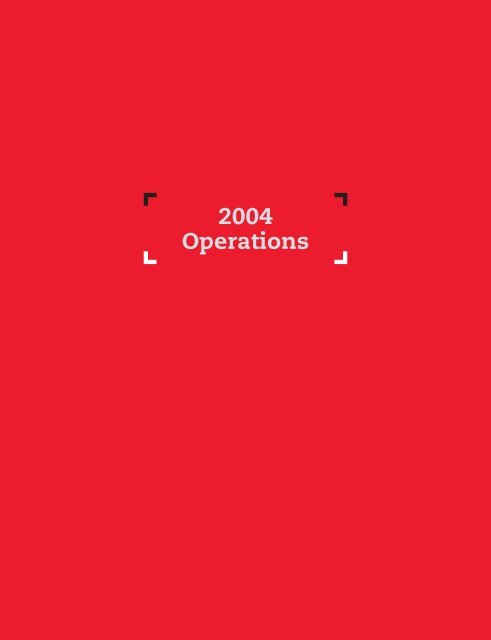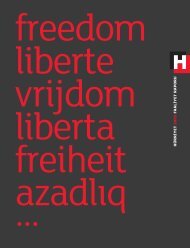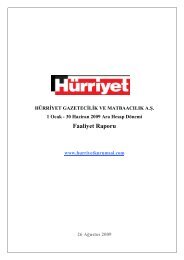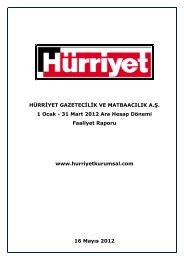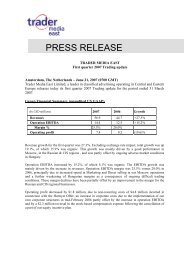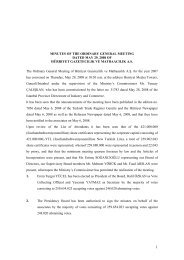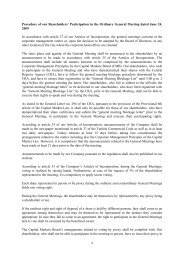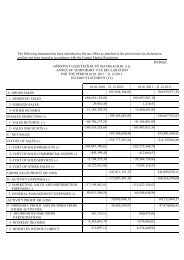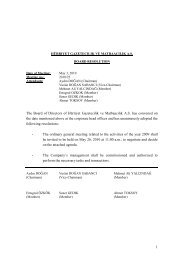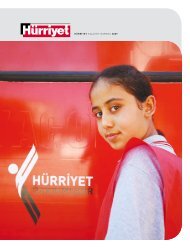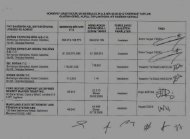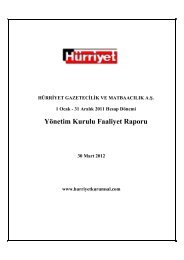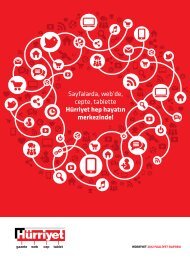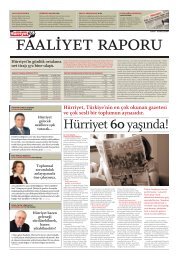2004 Operations
HURRIYET 04 FR ing.fh9
HURRIYET 04 FR ing.fh9
Create successful ePaper yourself
Turn your PDF publications into a flip-book with our unique Google optimized e-Paper software.
<strong>2004</strong><br />
<strong>Operations</strong>
HÜRR‹YET<br />
ANNUAL REPORT <strong>2004</strong><br />
Page 34<br />
<strong>2004</strong> <strong>Operations</strong><br />
Hürriyet has combined the effects of rapid economic growth<br />
in <strong>2004</strong> with successful management resulting in an increase<br />
of its advertising market share. Overall, Hürriyet’s total<br />
advertising revenue has grown by 47% in <strong>2004</strong>.<br />
Hürriyet: The leader of the media sector in <strong>2004</strong><br />
Turkey’s rapid economic growth in <strong>2004</strong><br />
was reflected in consumer spending thereby<br />
increasing advertising budgets. At the end of the<br />
year, total advertising market had reached<br />
approximately US$ 1,237 million, a 37% increase<br />
over that of the previous year. While the advertising<br />
market share for television commercials reached<br />
51%, the share of newspaper advertising has<br />
increased by 1%, to 36%. Nonetheless, over the past<br />
year, the newspaper advertising market has risen<br />
from US$ 312 million to US$ 443 million.<br />
Provided that economic growth continues,<br />
it is expected that total advertising spending in 2005<br />
will reach US$ 1.5 billion.<br />
Hürriyet, which benefited from the effects<br />
of rapid growth through successful management,<br />
increased its advertising market share. Overall,<br />
Hürriyet increased its total advertising revenue by<br />
47% in <strong>2004</strong>.<br />
2003-<strong>2004</strong> Total Advertising Revenue<br />
(US$ million)<br />
901<br />
1,237<br />
448<br />
1.400<br />
1.200<br />
1.000<br />
800<br />
600<br />
400<br />
200<br />
TOTAL<br />
TV<br />
NEWSPAPER<br />
MAGAZINE<br />
RADIO<br />
OUTDOOR<br />
MOVIES<br />
INTERNET<br />
36<br />
46<br />
40<br />
46<br />
47<br />
53<br />
11<br />
16<br />
7<br />
7<br />
626<br />
312<br />
443
To communicate to the<br />
advertising world that<br />
newspapers are the<br />
best means of<br />
advertising, Hürriyet<br />
organized the second<br />
“Red Awards.”<br />
Advertising revenue as a source for investments<br />
The increase in advertising spending in<br />
<strong>2004</strong> primarily came from the automotive industry,<br />
textile, construction, communication, information<br />
technology and beverage sectors. Hürriyet kept its<br />
number one position in human resources advertising<br />
and classified ads.<br />
Hürriyet’s Advertising Revenue<br />
2003-<strong>2004</strong><br />
(US$ million)<br />
125<br />
2003<br />
183<br />
<strong>2004</strong><br />
210<br />
200<br />
190<br />
180<br />
170<br />
160<br />
150<br />
140<br />
130<br />
120<br />
110<br />
Maintaining its market share of advertising<br />
revenue and raising the advertising unit price are<br />
among Hürriyet’s business targets for the coming<br />
years. To accomplish this, Hürriyet will develop<br />
specific projects aimed at increasing newspaper<br />
advertising.<br />
Additionally, Hürriyet plans to monitor the<br />
choice of venue made by advertisers, to inform the<br />
sales team of its findings and develop projects<br />
regarding sales strategies accordingly.<br />
Hürriyet’s advertising market share is 41.3%<br />
As has been the case in the past, Hürriyet<br />
was the media organization with the largest<br />
advertising market share in <strong>2004</strong>. Hürriyet’s share<br />
in the total advertising market has risen to<br />
14.8% - an increase of 0.9 points. Its share in the<br />
newspaper advertising market rose to 41.3% - an<br />
increase of 1.1 points.<br />
Hürriyet Advertising Market Share<br />
Hürriyet’s share in the total market<br />
Hürriyet’s share in the newspaper<br />
advertising market<br />
50<br />
In <strong>2004</strong>, Hürriyet’s total revenue from<br />
special projects amounted to US$ 6,461,767. Of this<br />
amount, US$ 1,513,206 came from 28 private-label<br />
newspapers (18 company-specific newspapers and<br />
10 industry-specific newspapers) and the balance<br />
is from sponsorship and special projects.<br />
To communicate to the advertising world<br />
that newspapers are the best means of advertising,<br />
Hürriyet organized the second “Red Awards.” As the<br />
first and only contest involving press advertisements<br />
in Turkey, “Red” has had the continuing support of<br />
the entire sector in its second year as a total of 830<br />
press advertisements from 85 advertising agencies<br />
entered the contest.<br />
40.2<br />
13.9 14.8<br />
2003<br />
<strong>2004</strong><br />
41.3<br />
40<br />
30<br />
20<br />
10
HÜRR‹YET<br />
ANNUAL REPORT <strong>2004</strong><br />
Page 36<br />
<strong>2004</strong> <strong>Operations</strong><br />
Despite limitations imposed on newspapers’ marketing<br />
and promotional activities by legal regulations<br />
passed in mid-2003, Hürriyet reached a circulation of<br />
495,000 - an increase of 7.60%.<br />
Sales as a competitive advantage<br />
According to the data gathered by the Press<br />
Advertising Organization, the average net sales of<br />
daily newspapers all over the country has increased<br />
by 8.56% and totaled 4,682,195 in <strong>2004</strong>; this figures<br />
previously stood at 4,313,045 in 2003. The reasons<br />
for this increase include the diminishing effect of<br />
Turkey’s 2001 economic crisis, the fact that<br />
segmentation among newspapers has become fully<br />
visible and low-price newspaper options were<br />
available to readers.<br />
Average Daily Circulation of<br />
Newspapers<br />
(units)<br />
4,313,045<br />
2003<br />
4,682,195<br />
Hürriyet aims to retain its reader profile<br />
along and to maintain its leading position in the<br />
market, therefore, it maintains its price level and<br />
does not employ a competitive pricing policy to<br />
raise its circulation. Despite the limitations brought<br />
upon the marketing and promotional activities of<br />
newspapers by the legal regulations passed in mid-<br />
2003, Hürriyet achieved a circulation of 495,000 -<br />
an increase of 7.6% to reach a market share of 10.9%.<br />
During <strong>2004</strong>, Hürriyet did not increase the<br />
price of weekday editions due in large part to the<br />
decrease in the inflation rates and the stabilization of<br />
<strong>2004</strong><br />
4,900,000<br />
4,800,000<br />
4,700,000<br />
4,600,000<br />
4,500,000<br />
4,400,000<br />
4,300,000<br />
4,200,000<br />
4,100,000<br />
Comparison of Hürriyet’s Circulation<br />
(in thousand units) 500<br />
495<br />
480<br />
460<br />
2003<br />
460<br />
440<br />
420<br />
the economy. On August 22, <strong>2004</strong>, Hürriyet raised the<br />
price for its Sunday edition -from YKR 35 to YKR 40.<br />
Hürriyet now reaches its readers through<br />
23,400 sales points in 81 cities, districts and other<br />
residential areas throughout the country. Of this<br />
total, 66.3% takes place in Turkey’s three largest<br />
cities; Istanbul, Ankara and Izmir. In comparison<br />
to its weekday circulation, sales of Hürriyet go up<br />
by 80,000 on Saturdays and 260,000 on Sundays.<br />
Hürriyet’s goal is to maintain its status as<br />
the best-selling newspaper and will continue to be<br />
the daily with the highest value. The following<br />
measures will be taken to ensure the<br />
accomplishment of this goal:<br />
• Maintain the continuity of a profitable selling price<br />
• Implement the practice of a special weekend price<br />
• Put out new supplements that increase sales<br />
turnover without creating loss<br />
• Undertake product differentiation to contribute<br />
to an increase in the turnover<br />
• Increase interaction with the reader so as to<br />
develop a more comprehensive database.<br />
<strong>2004</strong>
In the belief that it is<br />
indispensable that the<br />
publishing business to<br />
embrace life in all of<br />
its dimensions,<br />
Hürriyet prepares<br />
supplements and<br />
regional newspapers<br />
that add value to the<br />
lives of its readers and<br />
provide new<br />
opportunities for<br />
advertisers.<br />
Supplements addressing a diverse audience<br />
In the belief that it is indispensable that<br />
the publishing business to embrace life in all of its<br />
dimensions, Hürriyet prepares supplements and<br />
regional newspapers that add value to the lives of<br />
its readers and provide new opportunities for<br />
advertisers.<br />
Kelebek was re-published in <strong>2004</strong> and is<br />
one of Hürriyet’s most important trademark<br />
supplements. With its emergence into the market<br />
in March of <strong>2004</strong>, Kelebek filled a gap and has made<br />
a significant contribution to Hürriyet’s circulation<br />
(approximately 35,000 additional sales).<br />
These supplements are important factors<br />
that distinguish Hürriyet in the Turkish media.<br />
Hürriyet’s supplement ‹K has reinforced Hürriyet’s<br />
leadership in the field of human resources; it not<br />
only addresses professionals seeking to expand in<br />
their lives, but it also impacts institutions. It has<br />
also succeeded in becoming an important advertising<br />
medium.<br />
Putting an emphasis on rich content,<br />
Hürriyet Sunday has been developed to maintain<br />
the Newspaper’s leading position in the sector. The<br />
importance of its role is evident from the fact that<br />
based on Sunday sales, Hürriyet is by far the bestselling<br />
newspaper in Turkey.<br />
Utilizing this approach, in <strong>2004</strong> Hürriyet<br />
continued to release supplements addressing the<br />
needs and interests of diverse groups. Among them,<br />
the Travel supplement aims to become a domestic<br />
and international travel/culture guide for its readers,<br />
as well as an effective advertising vehicle for the<br />
tourism sector. Ever since its first issue was<br />
published, Travel has been well-received by Hürriyet<br />
readers, reaching an audience of 1,032,000 each<br />
week.<br />
Gaining momentum in the automotive<br />
industry, Hürriyet released its Auto Life supplement<br />
in 2003, thus targeting an emerging advertising<br />
potential. With a look at the world of automobiles<br />
from both male and female perspectives, Auto Life’s<br />
vivid content includes everything from novelties in<br />
the automotive industry to motor sports and<br />
commercial vehicles to financial services. Every<br />
week Auto Life reaches 1,212,000 readers.<br />
The share of regular weekly supplements<br />
in the total advertising revenue has risen to 21.2%<br />
in <strong>2004</strong>, up from 19.7% the previous year.<br />
By publishing supplements that increase<br />
turnover without incurring loss, Hürriyet will<br />
continue to offer its readers new choices as it grows<br />
in value.
HÜRR‹YET<br />
ANNUAL REPORT <strong>2004</strong><br />
Page 38<br />
<strong>2004</strong> <strong>Operations</strong><br />
In its effort to increase the quality of production through<br />
modernization, Hürriyet has continued making investments<br />
at the same pace as in previous years. It continues to obtain<br />
investment incentive certificates for future investments.<br />
Investments shaping the vision for the future<br />
Hürriyet has accomplished a significant<br />
portion of its investments. Ongoing projects aim at<br />
increasing productivity. Through investments made<br />
in template-typesetting, automatic stapling and folding<br />
systems, the printing facilities in Istanbul were fully<br />
equipped in 2003. At the same time, film preparation<br />
machines were purchased due to the increase in the<br />
number of published newspaper pages.<br />
These investments have enabled Hürriyet to<br />
achieve faster and more modern mass production as<br />
well as to respond appropriately to its advertisers’<br />
colored ad requirements. Newly acquired machinery<br />
was installed at the Esenyurt Printing Facilities, a<br />
project that began in 1999 and was completed in 2000.<br />
In the two years that followed, Hürriyet began<br />
production with its two Man Colorman printing presses,<br />
equipment manufactured with the latest technology<br />
for use by high-circulation newspapers. These<br />
machines have the capability to print a total of sixtyfour<br />
pages, forty of which can be printed in color. With<br />
the folding apparatus attached, it is possible to print<br />
two different newspapers simultaneously, each with<br />
a total of sixty-four pages.<br />
In an effort to increase the quality of<br />
production through modernization, Hürriyet continued<br />
making investments at the same pace as in previous<br />
years. It continues to obtain investment incentive<br />
certificates for future investments. A total of US$<br />
19,188,893 in <strong>2004</strong> has been invested in the printing<br />
facilities primarily in Adana, Istanbul, Ankara, Izmir<br />
and Antalya. The investment incentive certificates<br />
obtained in 2002 and in September <strong>2004</strong> were used to<br />
import machines totaling US$ 10,653,005.<br />
Investments in the Last Eight Years (1997 - <strong>2004</strong>)<br />
(US$ million)<br />
126.7 Machinery<br />
11.9 Other<br />
Total 226.0<br />
48.2 Land<br />
38.9 Building
The DPCs, which<br />
create operational<br />
synergy among Do¤an<br />
Yay›n Holding<br />
newspapers, also play<br />
an important role in<br />
cutting expenses<br />
through their ability<br />
to actualize large<br />
paper purchases and<br />
provide storage for all<br />
the Group’s<br />
newspapers.<br />
Printing Centers Capacity Utilization Ratio (%)<br />
DPC- ISTANBUL 86<br />
DPC-ANKARA 84<br />
DPC-IZMIR 90<br />
DPC-TRABZON 62<br />
DPC-ANTALYA 58<br />
DPC-ADANA 93<br />
DPC-FRANKFURT 65<br />
Printing as a part of Total Quality Management<br />
The DPCs, which create operational synergy<br />
between Do¤an Yay›n Holding newspapers, also<br />
play an important role in cutting expenses through<br />
their ability to actualize large paper purchases and<br />
provide storage for all the Group’s newspapers.<br />
Hürriyet is printed by facilities operating<br />
under the umbrella of the Do¤an Printing Center<br />
(DPC). In Turkey, printing is done in Istanbul, Ankara,<br />
Izmir, Antalya, Adana and Trabzon and in Germany<br />
in the Frankfurt facility. Do¤an Yay›n Holding, with<br />
its growing printing capability, combined the<br />
separate printing centers of Hürriyet and Milliyet<br />
in order to attain maximum efficiency and low-cost<br />
production and printing. In 1996, the printing<br />
facilities of the newspapers Hürriyet and Milliyet<br />
in Trabzon were combined and renamed Do¤an<br />
Printing Center. The same process was repeated in<br />
Ankara, Izmir, Antalya, Adana and finally in<br />
Istanbul, thus joining all printing operations under<br />
the DPC umbrella.<br />
In addition to Hürriyet and its supplements,<br />
these printing facilities provide services to other<br />
companies both within the Group and outside. They,<br />
therefore, contribute to the turnover and profitability<br />
of the Company. In <strong>2004</strong>, the DPCs’ total revenue<br />
amounted to YTL 102.2 million.<br />
The calculations are made on the basis of<br />
a 16-hour per day printing capacity for the printing<br />
presses.<br />
The DPCs provide innovative leadership in<br />
Turkey with regard to their stable growth and<br />
flexible, high-quality and productive work principles.<br />
They use 240,000 tons of paper annually and are<br />
among the most renowned facilities in the<br />
international newspaper industry.
HÜRR‹YET<br />
ANNUAL REPORT <strong>2004</strong><br />
Page 40<br />
<strong>2004</strong> <strong>Operations</strong><br />
The Istanbul DPC, with its 17,000-m 2 enclosed area,<br />
is the largest in Turkey in terms of capacity and is ranked<br />
second largest in Europe.<br />
The most important reason for the 26% rise in DPC revenue in the last year was the increase in the<br />
circulation and number of pages of Hürriyet and the other newspapers owned by the Group. This is also a<br />
major factor for the rise in DPC revenue now making up an approximate 22% share in Hürriyet’s total revenue.<br />
Production Category <strong>2004</strong> Total number of pages 2003 Total Number of Pages Increase %<br />
Main Newspaper 17,332,157,094 11,950,853,825 45.03<br />
Contracted Jobs 22,396,593,956 19,577,617,508 14.4<br />
TOTAL 39,728,751,050 31,528,471,333 26.0<br />
The Istanbul DPC, with its 17,000-m2<br />
enclosed area, is the largest in Turkey in terms of<br />
capacity; it is ranked the second largest in Europe.<br />
The facility features two Man Colorman printing<br />
presses, possessing the capacity to print 85,000<br />
copies per hour, each totaling sixty-four pages,<br />
including forty in color. The Istanbul DPC also has<br />
three Goss HT-70 printing presses. The Man printing<br />
presses are also linked to the Müller Martini “insert”<br />
system, a novel technological development allowing<br />
for the insertion of up to six inserts or supplements<br />
during or after the printing process.<br />
The facility is also furnished with the<br />
Computer-to-Plate (CTP) system, an innovative<br />
technological method that allows for the direct<br />
plating of the pages received from the editors and<br />
marking the first time this system was used in<br />
Turkey. This facility is equipped to handle the<br />
flawless, automatic plating of 4,800 templates per<br />
day, making the Istanbul DPC number one in the<br />
world in terms of the number of CTP templates<br />
produced at a single location.<br />
Also at the Istanbul DPC, printed paper or<br />
commercial inserts can be placed in newspaper<br />
copies during or after printing by the available insert<br />
system. Up to six inserts can be simultaneously<br />
placed into copies. A total of 200 tons of printed<br />
matter can be stored on the facility’s 350 rolls.<br />
Due to the modernization of the Company’s<br />
printing centers, waste was a minimal average of<br />
5.22% in <strong>2004</strong>.<br />
Investments as required by market<br />
conditions and competition will also continue in<br />
future years.
With an average daily<br />
circulation of 130,000-<br />
140,000, Hürriyet is<br />
both the best-selling<br />
Turkish newspaper in<br />
Europe and one of the<br />
best-selling foreign<br />
daily newspapers on<br />
the continent.<br />
Access beyond borders: <strong>Operations</strong> in Europe<br />
As Turkey’s only paper with global access,<br />
Hürriyet operates in Europe through its office in<br />
Mörfelden Walldorf, a town near Frankfurt, Germany<br />
and its huge printing facility there, a branch of the<br />
DPC. Hürriyet, meeting the need for news and<br />
comments of Turkish people living in Western<br />
Europe, is also an important source of news for<br />
regional events, owing to its strong network of<br />
reporters in these countries.<br />
With an average daily circulation of 130,000-<br />
140,000, Hürriyet is both the best-selling Turkish<br />
newspaper in Europe as well as the one of the bestselling<br />
foreign daily newspapers on the continent.<br />
Hürriyet’s availability abroad is not limited<br />
to countries in Western Europe. In addition to its<br />
distribution from 20,000 sales locations in Germany,<br />
Hürriyet reaches another 24 countries at 30,000<br />
locations across Europe through the Axel-Springer<br />
distribution network. Today, Hürriyet is read<br />
throughout the continent, all the way from England<br />
to Romania and from the countries of Scandinavia<br />
to Italy; it also reaches as far as Canada.<br />
The Hürriyet-USA daily which had been<br />
printed in Germany and sent to USA has been<br />
printed in New York as of November 1, <strong>2004</strong>. At the<br />
same time, it is also published daily in several other<br />
states other than New York.<br />
Hürriyet manages its operations abroad<br />
under the umbrella of DMG International, which<br />
was founded in 1999 to function as Do¤an Yay›n<br />
Holding’s gateway to Europe. The Company oversees<br />
most of DYH’s publications and broadcasting<br />
targeting Turkish people living in Europe. It also<br />
plays an important role in enhancing DYH’s<br />
relationship and communication with Europe’s<br />
leading media companies. With an average daily<br />
circulation of 165,000 across Europe via Hürriyet,<br />
Milliyet and Fanatik, DMG International raises the<br />
banner for DYH as a market leader on the continent.<br />
In addition to DMG International<br />
publications, the printing facilities produce the<br />
Germany edition of the international finance<br />
newspaper, The Wall Street Journal Europe, the<br />
American newspaper Stars&Stripes and Sportwelt,<br />
the German sports paper. With these foreign<br />
publications, the total number of newspapers<br />
produced at the printing facilities amount to<br />
215-235 thousand units.<br />
The advertising revenue of Hürriyet Europe<br />
newspaper totaled 6.6 million in 2003 and 6.5<br />
million in <strong>2004</strong>.
HÜRR‹YET<br />
ANNUAL REPORT <strong>2004</strong><br />
Page 42<br />
<strong>2004</strong> <strong>Operations</strong><br />
With its rich filling content, an average of almost two million<br />
monthly visitors and 90 million hits, Hürriyetim is the<br />
leading Internet publication in Turkey and among the<br />
foremost in Europe.<br />
Internet services with a global approach<br />
Among Hürriyet’s major business aims is<br />
to maintain its leading status not only in the printed<br />
press but in the Internet news sector as well. For<br />
this reason the Hürriyet online was founded on<br />
January 1, 1997. Following the adoption of the name<br />
Hürriyetim in December 1999, Hürriyet became one<br />
of the first newspapers to be Internet accessible. In<br />
October 2000, hurriyetim.com.tr shed its status as<br />
merely the Internet version of the Hürriyet<br />
newspaper and began serving as a 24-hour news<br />
portal reporting the day’s events around the clock.<br />
Formerly operating as a division of Hürriyet<br />
Gazetecilik ve Matbaac›l›k A.fi., Hürriyetim became<br />
a Hürriyet affiliated company called Hürriyet<br />
Internet Hizmetleri ve Ticaret A.fi. on January 1,<br />
2001.<br />
With its rich content, an average of nearly<br />
two million monthly visitors and 90 million hits,<br />
Hürriyetim is the leading Internet publication in<br />
Turkey and among the foremost in Europe. In <strong>2004</strong>,<br />
Hürriyetim overall revenue accrued from content<br />
services to companies outside the Group, from<br />
banner sales and from special projects such as the<br />
Green Card and Mobile Hürriyetim totaled YTL<br />
1,355,910.<br />
In 2005, Hürriyetim plans to develop and<br />
implement new and creative approaches, including<br />
making the website more user-friendly by renewing<br />
the content management infrastructure and<br />
developing interactive tools for it.<br />
Human resources subject to performance analysis<br />
As a result of the Search Conferences<br />
organized at the beginning of 2003, the Company<br />
established the Human Resources Committee, for<br />
the purpose of development and restructuring. In<br />
executing the project, the team, comprised of<br />
employees from the Media Group, Treasury,<br />
Information Systems, Advertising, Payroll and<br />
Human Resources, inspected all aspects of<br />
operations in the human resources processes,<br />
determined shortcomings, generated creative<br />
solutions and began the implementation process.<br />
This took place in twelve meetings that lasted a<br />
total of 35 hours. In this context, the team updated<br />
Job Descriptions and Organizational Charts, created<br />
a new Performance Evaluation System, assessed<br />
and renovated the Search and Recruitment Processes<br />
and evaluated the Training Management.<br />
The Search Conference also was<br />
instrumental in the formation of the<br />
Communications Committee and to implement<br />
necessary improvements in the human resources<br />
processes. The basis of this human resources<br />
enhancement project included dealing with such<br />
issues as the lack of information-sharing within the<br />
Company, the lack of communication, the<br />
insufficient appreciation of employees and the lack<br />
of a fair system of wages.<br />
In the update of job descriptions phase,<br />
Division heads had meetings with all groups in order<br />
to ensure the greatest possible employee<br />
participation. These meetings, lasting a total of 130<br />
hours, resulted in the renewal of the format of job<br />
descriptions, including the rectification of its<br />
shortcomings and bringing the system into full<br />
compliance with all amendments in the labor laws<br />
in 2003. Thus, the renewed job descriptions now<br />
fully address the requirements of both business<br />
demands and performance criteria for all employees.
Established to facilitate success and create<br />
high-quality human resources with high<br />
performance, the Performance Evaluation System<br />
is expected to measure Performance Highlights and<br />
Competencies, including individual, functional and<br />
administrative competencies. This system will allow<br />
individual employees to evaluate themselves, as<br />
well as assessment by their supervisors and<br />
colleagues. The biannual performance evaluation<br />
system forms the basis of the Wage Management<br />
and Rewards System, Career Planning and Training<br />
Management.<br />
The overall goal is to establish competitive<br />
and egalitarian recruitment and an employment<br />
system that produces quality work with the<br />
appropriate human resources. Toward this end, a<br />
new electronic system called the Question Bank has<br />
been set up to support Recruitment Management.<br />
This system will be extended to the entire Company;<br />
it aims to fairly and accurately evaluate the general<br />
cultural and professional knowledge of the<br />
applicants by means of an exam given prior to the<br />
initial interview for each position.<br />
Comprehensive training sessions were<br />
organized in <strong>2004</strong>, primarily for the Media Group.<br />
Plans for training all groups are in place for 2005.<br />
In <strong>2004</strong>, the systems designed in 2003 as<br />
parts of the enhancement program for Human<br />
Resources started to be implemented. These systems<br />
include recruitment and employment, performance<br />
evaluation, fair wages and training systems. The<br />
designing phase of performance evaluation system<br />
was completed in April, <strong>2004</strong> and tested in some<br />
pilot divisions during May <strong>2004</strong> and implemented<br />
throughout the corporation in December <strong>2004</strong>. In<br />
January 2005, the results of the performance<br />
evaluation system for the first time were reflected<br />
in an increase in wages.<br />
The performance evaluation system<br />
developed by Do¤an Yay›n Holding for all of its<br />
subsidiaries is based on Hürriyet’s performance<br />
evaluation system. Two officers from Hürriyet’s<br />
Human Resources Department joined the project<br />
team organized within the scope of this study. With<br />
the new system constituted throughout entire Do¤an<br />
Yay›n Holding, all terms of reference and<br />
organizational structure are redefined in the<br />
Holding-wide deployed personnel system.<br />
The test bank system, completed in 2003,<br />
was initially used for the selection of Economy<br />
Correspondence and then for the Intelligence<br />
Correspondence positions, producing very successful<br />
results. Of the employees hired utilizing this test<br />
bank, 90% are still continuing to work at the<br />
Holding’s enterprises.<br />
Together with an HR consultation company,<br />
an efficiency and workload study has been initiated.<br />
The service contracts of the employees at all<br />
establishments affiliated with Hürriyet’s Human<br />
Resources Department are renewed pursuant to the<br />
amended labor law.<br />
The terms of reference and organizational<br />
structure of other establishments affiliated to<br />
Hürriyet’s Human Resources Department have been<br />
updated.<br />
Company-wide human resources reporting<br />
standards have been restructured at Hürriyet; the<br />
initial implementation was carried out in January<br />
2005. These standards will be implemented at all<br />
related establishments within a planned period.
HÜRR‹YET<br />
ANNUAL REPORT <strong>2004</strong><br />
Page 44<br />
<strong>2004</strong> <strong>Operations</strong><br />
On September 18, 2005, Hürriyet started a campaign in<br />
collaboration with Contemporary Education Foundation (Ça¤dafl<br />
E¤itim Vakf›) and the Governorship of Istanbul, to prevent<br />
domestic violence. The campaign “Stop Domestic Violence!”<br />
also won an award in the category of Social Responsibility<br />
Project in the <strong>2004</strong> Creativity Awards organized by DYH.<br />
Comprehensive projects of social responsibility<br />
As an integral part of its role in Turkey’s<br />
modernization process, Hürriyet believes it should<br />
do its part in attending to social problems. Hürriyet’s<br />
illustrious history is replete with examples of<br />
campaigns that support this position. In 1983, a fund<br />
raising campaign was conducted to help the families<br />
of the 96 people who died in the mine explosion at<br />
Kozlu, Zonguldak. Likewise, the “You Add a Brick,<br />
too” campaign was organized to help heal the<br />
devastation of the August 17, 1999 earthquake, the<br />
largest aid operation ever organized in Turkey.<br />
“Stop Domestic Violence!” campaign<br />
Globally, one out of four females and one<br />
male out of six will become a victim of domestic<br />
violence at some time in their life. According to the<br />
data collected by the government’s Family Studies<br />
Organization in Turkey, physical violence is seen in<br />
one family out of three while verbal abuse occurs in<br />
one out of two families. Women and children are the<br />
most frequent victims of serious and violent abuse.<br />
Hürriyet sees domestic violence as a fundamental<br />
social problem that can neither be tolerated nor accepted<br />
as an ordinary phenomenon. The harm it does to family<br />
members is impossible to erase without years of<br />
intervention. Aside from this, the goal of the “Stop<br />
Domestic Violence!” campaign is to uncover the source<br />
of domestic violence throughout the family, especially<br />
with regard to women and children, to contribute to<br />
establishment of non-violent families and to invite all<br />
the social groups to say “Stop Domestic Violence!”<br />
On October 18, <strong>2004</strong>, the first meeting of the<br />
“Stop Domestic Violence!” campaign was held in the<br />
Çetin Emeç Hall at Hürriyet Media Towers. Hürriyet’s<br />
Chief Executive Officer Vuslat Do¤an Sabanc› and<br />
Editor-in-Chief Ertu¤rul Özkök discussed Hürriyet’s<br />
reason for targeting this situation which constitutes<br />
a serious social problem in Turkey.<br />
The campaign was created to take a public<br />
stance against domestic violence - a crucial problem<br />
the world over - and to initiate social transformation<br />
from such a position.<br />
Mobile Classrooms offer Training Sessions in Istanbul<br />
Within the scope of this campaign, Hürriyet<br />
organized an Assistance Program to help improve<br />
communication within families in collaboration with<br />
Contemporary Education Foundation and the<br />
Governorship of Istanbul. During the first stage,<br />
training sessions for participants, male and female,<br />
were provided in a specially redesigned bus that<br />
served as a mobile classroom in Gaziosmanpafla,<br />
Ümraniye, Ka¤›thane and Bak›rköy districts. These<br />
sessions covered a whole array of topics;<br />
comprehensive description of domestic violence, the<br />
influences of violence on family members, the<br />
differences between men and women with respect<br />
to domestic violence, alternative problem-solving<br />
methods without resorting to violence, the concept<br />
of the good and powerful husband/father, anger<br />
control, the Family Protection Law and ways of coping<br />
with violence. At the end of training session, each<br />
participant was given special buttons, a method<br />
enabling the participants to help convey such<br />
information to others and attract more visitors to<br />
the mobile classroom.<br />
Erroneous beliefs about Domestic Violence<br />
As part of the campaign, a booklet titled<br />
Domestic Violence – Erroneous Beliefs was produced<br />
with contributions and suggestions by the Advisory<br />
Board involving, among other members, Nazan<br />
Moro¤lu, the former president of the Association of<br />
Istanbul Women’s Organizations and Vildan<br />
Yirmibeflo¤lu; the president of the Provincial Board<br />
of Human Rights in the Governorship of Istanbul.<br />
This booklet was prepared by Psychologist Nevin<br />
Dölek and Consultant Psychologist Neylan Özdemir.<br />
It contains information about the erroneous beliefs<br />
regarding domestic violence and offers suggestions<br />
and problem-solving methods other than violence<br />
to cope with domestic problems that often lead to<br />
violence.
One of the most<br />
significant parts of the<br />
campaign was a<br />
training project held in<br />
collaboration with<br />
Hürriyet,<br />
Contemporary<br />
Education Foundation<br />
and the Governorship<br />
of Istanbul.<br />
Campaign’s website<br />
On the campaign’s website, , in-depth<br />
information, sources and news about domestic<br />
violence and up-to-date information about the<br />
campaign are available. The site, aiming to be a<br />
platform about domestic violence, has had many<br />
visitors and emails sent by people who have<br />
personally suffered from violence or who have<br />
witnessed it in their neighborhood.<br />
Assistance Program to Help Improve Marital<br />
Relationships<br />
This program has reached 1,500 people<br />
from the Gaziosmanpafla, Ümraniye, Bak›rköy and<br />
Ka¤›thane districts in just its first three months and<br />
has been much appreciated by local authorities.<br />
The municipalities and non-governmental<br />
organizations from Istanbul and its surroundings<br />
are asking about possible expansion of the program.<br />
The training sessions and the campaign will continue<br />
during 2005.<br />
“Stop Domestic Violence!” campaign in Europe<br />
The campaign also reached the European<br />
press, appearing in two newspapers in Holland as a<br />
model program from Turkey. This campaign triggered<br />
by Hürriyet in Turkey has also started in Germany<br />
and in other parts of Europe as well. On February<br />
12, Hürriyet Europe’s printing facilities near Frankfurt<br />
hosted young volunteers who were instructed in a<br />
special training seminar given by the Turkish<br />
campaign team and specialists from Germany.<br />
“Let Our Schools Not Be Destroyed” campaign<br />
More recently, the need to increase public<br />
awareness was once again made apparent by the<br />
tragic earthquake in Bingöl on May 1, 2003 which<br />
resulted in the deaths of 82 innocent children.<br />
Following this disaster, Hürriyet launched the “Let<br />
Our Schools Not Be Destroyed” campaign in<br />
association with the National Education Foundation<br />
as well as several universities. The purpose of this<br />
drive was to help take precautionary measures<br />
against the destruction of schools during possible<br />
future earthquakes and to ensure that this subject<br />
stays in the public eye. Within the framework of<br />
this campaign earthquake reinforcement projects<br />
were undertaken at 130 school buildings in highrisk<br />
earthquake-prone regions.<br />
Project and the Methodology<br />
Turkey has 60,000 schools, of which 35,000<br />
are elementary schools attended by a total of 16<br />
million students. The basic problem is that there is<br />
often very little knowledge about the earthquake<br />
sturdiness of these schools, especially in light of<br />
the tragedy in Bingöl where 82 children lost their<br />
lives in what was basically a medium-strength<br />
earthquake.<br />
The primary goal of Hürriyet’s campaign is<br />
designed to provide the following aid (in 30 cities)<br />
to the 190 regional elementary boarding schools<br />
and elementary schools with boarding facilities:<br />
• soil surveys<br />
• earthquake resistance testing for buildings<br />
• reinforcement of buildings that need to be<br />
strengthened<br />
• renovation of buildings that need to be reinforced<br />
• demolition of buildings which have outlasted their<br />
economic life-span (that is, which cannot be salvaged<br />
by reinforcements) and the construction of new<br />
buildings<br />
Result<br />
The project has since been handed over to<br />
the Ministry of Education; the main responsibility<br />
of Hürriyet and other individuals and groups who<br />
have supported this venture has come to an end.<br />
The Ministry of Education has taken on this trust<br />
and responsibility; the necessary tests,<br />
improvements and renovations are ongoing.<br />
Hürriyet, with its strong sense of journalistic
HÜRR‹YET<br />
ANNUAL REPORT <strong>2004</strong><br />
Page 46<br />
<strong>2004</strong> <strong>Operations</strong><br />
Hürriyet’s paid-in capital was increased by 70% from YTL<br />
245,142,682 to YTL 416,742,560 by means of a capital increase<br />
through issuance of bonus shares.<br />
Strong profits command financial ratios<br />
Financial strength, profitability and payment performance ratios, the measures reflecting the Company’s<br />
overall financial performance, calculated on past two years’ data and in accordance with the CMB<br />
Communiqué Series XI, No. 25, are as follows:<br />
<strong>2004</strong> 2003<br />
Current Ratio (Current Assets / Short-term Liabilities) 2.92 2.58<br />
Asset Turnover (Net Sales / Total Assets) 0.57 0.56<br />
Total Liabilities / Shareholders’ Equity 0.41 0.38<br />
Financial Expenses / Total Assets 0.03 0.06<br />
Operating Profit / Total Assets 0.09 0.06<br />
Operating Profit / Net Sales 0.15 0.12<br />
Net Operating Profit / Net Sales 0.13 0.03<br />
Gross Profit Margin 0.35 0.33<br />
Information about capital structure<br />
The registered capital ceiling of the<br />
Company as of December 31, <strong>2004</strong>, was YTL<br />
500,000,000; its paid-in capital is YTL 416,742,560.<br />
The Company has increased its registered<br />
capital ceiling from YTL 250,000,000 to YTL<br />
500,000,000 by the authorization Number 58/143<br />
dated November 14, 2003 by the Capital Markets<br />
Board and a resolution of its Extraordinary General<br />
Shareholders Meeting held on January 15, <strong>2004</strong>. This<br />
decision necessitated the following changes in the<br />
Articles of Association: Article 11 - Registered Capital;<br />
Article 10 - Capital Increases and Decreases; Article<br />
14 - Transfer and Change of Shares; Article 34 -<br />
Fees; Article 36 - Provisions to be Applied and; Article<br />
38 - Notification of the Meetings to the Ministry of<br />
Trade and the Commissary’s Attendance. The<br />
increase in the capital ceiling of the Company as<br />
well as the associated amendments made in the<br />
Articles of Association has been registered and<br />
announced through the Trade Registry Gazette<br />
No. 5978 dated January 29, <strong>2004</strong>.<br />
The Company distributed to its shareholders<br />
an amount of YTL 24,518,945, constituting 50% of<br />
its distributable net profit for the 2003 period (YTL<br />
47,094,534), as cash dividends (TL 100.02 per share<br />
of TL 1.000 in nominal value). An amount of YTL<br />
526,414 from the remaining profit was spared as<br />
second legal reserves and YTL 23,899,990 as<br />
extraordinary reserves in accordance with the Article<br />
466/2 of the Turkish Commercial Code. With the<br />
resolution of Board of Directors on June 22, <strong>2004</strong>,<br />
Number 28 and the authorization given by the<br />
Capital Markets Board on July 13, <strong>2004</strong>, Number<br />
111/848, the Company’s paid-in capital amounting<br />
to YTL 245,142,682 was increased to YTL 416,742,560<br />
(at a rate of 70%) by an additional YTL 171,599,878.<br />
The major shareholder of Hürriyet<br />
Gazetecilik ve Matbaac›l›k A.fi. is Do¤an Yay›n<br />
Holding A.fi. holding 60% of the shares.
Donations and aids<br />
The following table presents the Company’s<br />
<strong>2004</strong> donations to several foundations and<br />
associations in an effort to contribute to<br />
public welfare:<br />
Values not included in consolidated<br />
financial statements<br />
Values not included in consolidated financial<br />
statements prepared in accordance with IFRS are<br />
the following:<br />
(YTL)<br />
Ayd›n Do¤an Foundation 1,082,638<br />
Kelkit Vocational High School 531,000<br />
“Let Our Schools Not<br />
Be Destroyed” Campaign 150,000<br />
Atatürk University Kelkit<br />
Vocational School 145,356<br />
Other public welfare establishments<br />
and associations 134,109<br />
Total 2,043,103<br />
Guarantees and<br />
commitments given 147,647,672<br />
Mortgages given 43,012,500<br />
Letters of guarantee given 1,915,631<br />
Bonds given 202,223<br />
Collateral bonds given 1,714<br />
Total 192,779,740<br />
Insured value of assets 217,539,452<br />
Letters of guarantee received 10,822,362<br />
Total 228,361,814<br />
Personnel movements<br />
The total number of employees was 1,615<br />
in 2003; it increased to 2,428 during <strong>2004</strong>.<br />
Employees’ net wages are increased twice a<br />
year; in January <strong>2004</strong>, the net increase was 6.5%<br />
and 5.7% in July <strong>2004</strong>.<br />
The amount of employment termination<br />
indemnity liability of the Company, calculated on<br />
the basis of the gross wages of its staff subject to<br />
the laws Number 1475 and 5953 (212) and in<br />
accordance with the CMB Communiqué Series XI,<br />
Number 25, was YTL 7,054,348.
HÜRR‹YET<br />
ANNUAL REPORT <strong>2004</strong><br />
Page 48<br />
<strong>2004</strong> <strong>Operations</strong><br />
Profit distribution proposal and conclusion<br />
With the decision on February 25, 2005 and of Number 7/242, the Capital Markets Board (CMB)<br />
set the basis for the distribution of <strong>2004</strong> profits for the corporations subject to the Capital Market Law.<br />
Considering the Turkish Commercial Code, Capital Market Legislation and CMB regulations,<br />
Corporate Tax, Income Tax and other legislation, the relevant article of the Articles of Association relating<br />
to profit distribution and the profit distribution policy for the subsidiaries where the majority shareholder<br />
is Do¤an Yay›n Holding as announced on September 29, 2003, the Company decided to distribute in cash<br />
50% of the net distributable profit for <strong>2004</strong>.<br />
Allowing for corporate tax payables, deferred tax provisions and minority profits and in accordance<br />
with CMB Communiqué Series: XI, Number: 25, consolidated net profit for the year in financial statements<br />
prepared in accordance with International Financial Reporting Standards (IFRS) is YTL 27,200,087. Net<br />
distributable profit for the year is YTL 24,981,084; it is found after first legal reserves amounting to YTL<br />
1,936,990 is deduced in accordance with the Article 446/1 of the Turkish Commercial Law. An additional<br />
amount of YTL 282,013 is also deducted in the consolidated financial statements, which represents the<br />
profits of the subsidiaries that have not yet concluded their General Assemblies regarding profit distribution.<br />
The net profit for the year in legal records is YTL 38,739,806.<br />
Hence, the Company has decided to propose to the Ordinary General Assembly Meeting the<br />
distribution of YTL 12,490,542, 50% of YTL 24,981,084 calculated as distributable net profit for the year,<br />
as cash dividends while sparing the remaining balance of YTL 12,490,542 as extraordinary reserves.<br />
The profit shall be distributed in the following way:<br />
of every share with YTL 1 nominal value, dividends will be paid at a rate of 3% of paid-in capital.<br />
1. Net YTL 0.029972 for full-fledged taxpayers<br />
2. Gross YTL 0.029972 and net YTL 0.02697 for real persons and establishments exempt from taxes<br />
3. Gross YTL 0.029972 and net YTL 0.02697 for limited liability real persons and limited liability<br />
establishments<br />
These amounts, presented here only for demonstration purposes, to be paid per share of YTL 1<br />
nominal value will be rounded off to whole numbers as YKR during profit distribution.<br />
Balance Sheet and Income Statement for the year <strong>2004</strong> and the proposal to discharge the Board<br />
Members and Statutory Auditors off their liabilities are presented to the approval of the General Assembly.
Performance of Hürriyet’s shares<br />
Hürriyet’s stocks have created value over the ISE-100 Index for its investors since going public<br />
in 1992. As a result, Hürriyet’s stock rank first within the most popular stocks among foreign investors.<br />
By the end of <strong>2004</strong>, 40% of Hürriyet’s stocks have been offered to the public; 85% of these stocks<br />
are internationally owned. Non-publicly traded stocks (60%) belong to Do¤an Yay›n Holding A.fi.<br />
Among the newspapers published in Turkey, Hürriyet has the strongest financial structure and<br />
is the first and only media company in Turkey to receive a credit rating from an international rating<br />
agency. With a credit rating of B+ (stable outlook) in long-term foreign currency, a B+ (positive outlook)<br />
in long-term domestic currency and a national rating of A+ (Tur) assigned by FitchRatings, Hürriyet has<br />
emerged as one of Turkey’s most successful businesses in terms of creditworthiness.<br />
Hürriyet’s Market Value February 1992 - February 2005<br />
(End-of-Month Closing Prices)<br />
1,200<br />
Hürriyet’s Market Value (US$ millions)<br />
ISE-100 Index (Usc)<br />
12.00<br />
1,000<br />
10.00<br />
US$ millions<br />
800<br />
600<br />
8.00<br />
6.00<br />
1992<br />
1993<br />
1994<br />
1995<br />
1996<br />
1997<br />
1998<br />
1999<br />
2000<br />
2001<br />
2002<br />
2003<br />
<strong>2004</strong><br />
Usc<br />
400<br />
4.00<br />
200<br />
2.00


